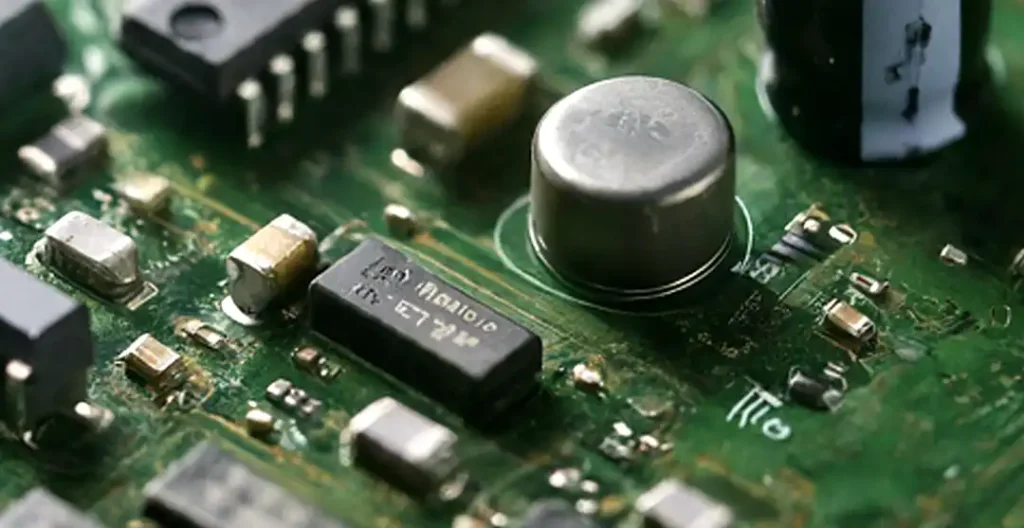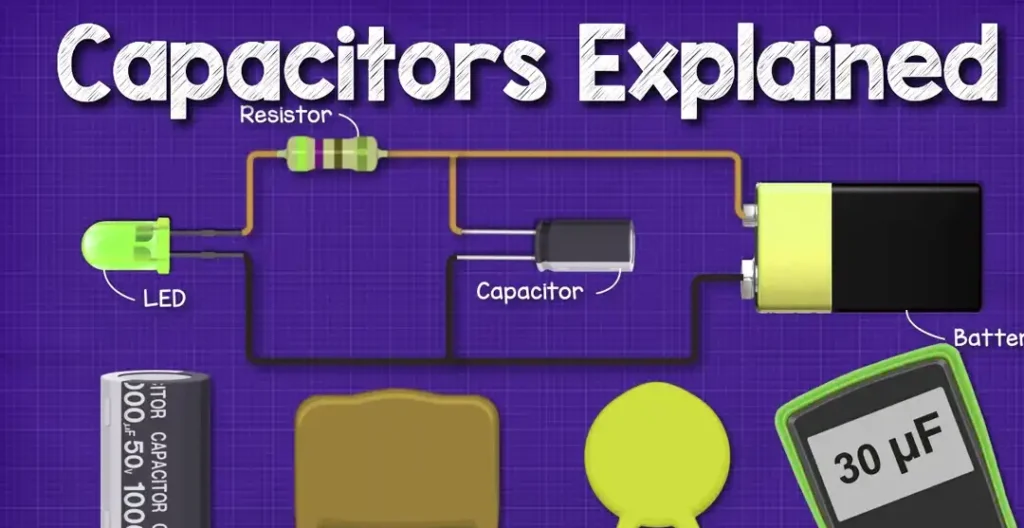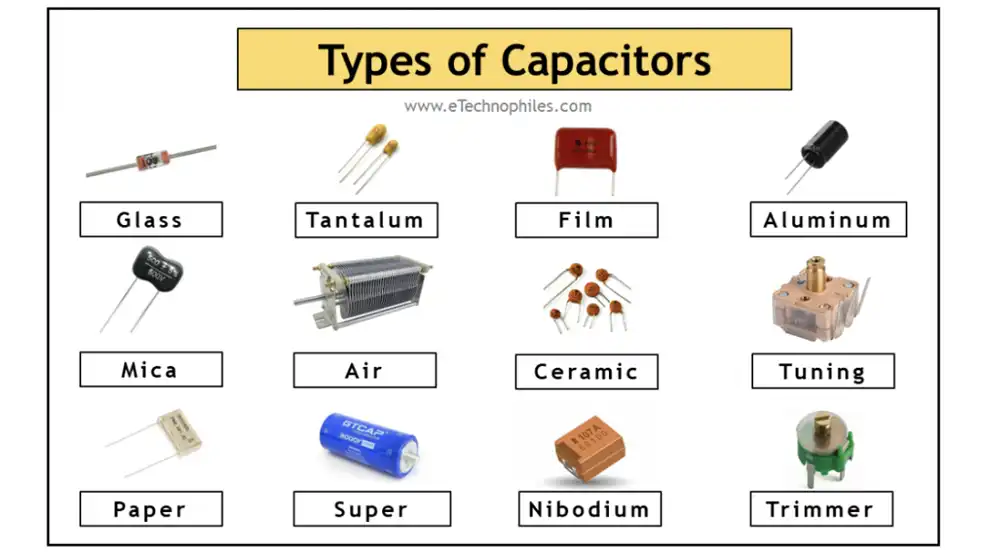Capacitors are fundamental components in electronic circuits, storing and releasing electrical energy as needed. Understanding the different types of capacitors is essential for designing and building various electronic devices.
In this article, we delve into the diverse world of capacitors, exploring their types, functions, and applications.
What is a Capacitor?

A capacitor is a passive electronic component that stores energy in the form of an electric field. It consists of two conductive plates separated by an insulating material known as the dielectric. When a voltage is applied across the plates, an electric field is established, storing energy proportional to the applied voltage.
How Do Capacitors Work?

Capacitors function based on the principle of capacitance, which is the ability to store electric charge. When a voltage is applied, positive charge accumulates on one plate while an equal amount of negative charge accumulates on the other. This separation of charge creates an electric field, storing energy. When the voltage is removed, the stored energy is released.
Types of Capacitors

Glass Capacitors:
Glass capacitors, also known as glass dielectric capacitors, utilize glass as the dielectric material between the conductive plates. They are known for their stability, high voltage ratings, and low leakage current. Glass capacitors are often used in high-voltage and high-frequency applications where reliability and precision are essential, such as in medical equipment and precision measuring instruments.
- Dielectric Material: Glass
- Characteristics: Known for stability, high voltage ratings, and low leakage current.
- Applications: High-voltage and high-frequency applications where precision and reliability are crucial, such as medical equipment and precision measuring instruments.
Tantalum Capacitors:
Tantalum capacitors utilize tantalum metal as the electrode material and an electrolyte as the dielectric. They offer high capacitance density, excellent stability, and low leakage current. Tantalum capacitors are commonly used in portable electronic devices, telecommunications equipment, and automotive electronics due to their compact size and reliability.
- Dielectric Material: Tantalum metal with an electrolyte
- Characteristics: High capacitance density, excellent stability, and low leakage current.
- Applications: Portable electronic devices, telecommunications equipment, and automotive electronics due to their compact size and reliability.
Film Capacitors:
Film capacitors use a thin plastic film, such as polyester, polypropylene, or metalized film, as the dielectric material. They are known for their excellent insulation properties, high reliability, and low leakage current. Film capacitors are versatile and find applications in power supplies, motor drives, lighting ballasts, and audio equipment.
- Dielectric Material: Thin plastic film (polyester, polypropylene, or metalized film)
- Characteristics: Excellent insulation properties, high reliability, and low leakage current.
- Applications: Power supplies, motor drives, lighting ballasts, and audio equipment.
Aluminum Capacitors:
Aluminum capacitors, also known as electrolytic capacitors, utilize an aluminum oxide layer as the dielectric. They offer high capacitance values in a compact size and are suitable for applications requiring large energy storage, such as power supplies and audio amplifiers. Aluminum capacitors are polarized and must be connected with the correct polarity to prevent damage.
- Dielectric Material: Aluminum oxide layer
- Characteristics: High capacitance values in a compact size.
- Applications: Power supplies, audio amplifiers, and other applications requiring large energy storage.
Mica Capacitors:
Mica capacitors use mica as the dielectric material, providing excellent stability over a wide temperature range and low dielectric losses. They are commonly used in high-frequency and high-voltage applications, such as radio frequency (RF) circuits, telecommunication equipment, and medical devices.
- Dielectric Material: Mica
- Characteristics: Excellent stability over a wide temperature range and low dielectric losses.
- Applications: High-frequency and high-voltage applications such as RF circuits, telecommunication equipment, and medical devices.
Air Capacitors:
Air capacitors, also known as variable capacitors or tuning capacitors, have air as the dielectric material. They consist of two or more plates separated by air gaps, allowing the capacitance value to be adjusted manually or electronically. Air capacitors are used in tuning circuits for radio receivers, oscillators, and frequency synthesizers to adjust the resonance frequency.
- Dielectric Material: Air
- Characteristics: Capacitance value adjustable manually or electronically.
- Applications: Tuning circuits for radio receivers, oscillators, and frequency synthesizers.
Ceramic Capacitors:
Ceramic capacitors use ceramic material as the dielectric, offering high stability, reliability, and temperature tolerance. They come in various types, including multilayer ceramic capacitors (MLCCs) and ceramic disc capacitors. Ceramic capacitors are widely used in consumer electronics, automotive systems, and industrial equipment due to their small size and high capacitance values.
- Dielectric Material: Ceramic
- Characteristics: High stability, reliability, and temperature tolerance.
- Applications: Consumer electronics, automotive systems, and industrial equipment
Tuning Capacitors:
Tuning capacitors, also known as variable capacitors or trimmer capacitors, are used to adjust the resonance frequency of circuits. They consist of two or more plates separated by a dielectric material, with the capacitance value adjustable by rotating a knob or applying voltage. Tuning capacitors are essential components in radio frequency (RF) circuits, antennas, and oscillators.
- Dielectric Material: Various, including air or dielectric material.
- Characteristics: Adjustable capacitance value for tuning circuits.
- Applications: Radio frequency (RF) circuits, antennas, and oscillators.
Paper Capacitors:
Paper capacitors use paper impregnated with oil or wax as the dielectric material. They were commonly used in early electronic devices but have largely been replaced by modern film capacitors due to their inferior performance and reliability. Paper capacitors are now primarily used in vintage equipment restoration and historical electronics projects.
- Dielectric Material: Paper impregnated with oil or wax
- Characteristics: Historical use, replaced by modern capacitors due to inferior performance.
- Applications: Vintage equipment restoration and historical electronics projects.
Supercapacitors:
Supercapacitors, also known as ultracapacitors or double-layer capacitors, have high capacitance values and can store a significant amount of energy. They differ from traditional capacitors by using electrochemical double-layer capacitance or pseudocapacitance for energy storage. Supercapacitors are used in applications requiring rapid energy storage and release, such as hybrid vehicles, renewable energy systems, and regenerative braking systems.
- Dielectric Material: Electrochemical double-layer capacitance or pseudocapacitance.
- Characteristics: High capacitance values and rapid energy storage/release.
- Applications: Hybrid vehicles, renewable energy systems, and regenerative braking systems.
Niobium Capacitors:
Niobium capacitors utilize niobium metal as the electrode material and a niobium oxide layer as the dielectric. They offer high capacitance values, low equivalent series resistance (ESR), and excellent stability over a wide temperature range. Niobium capacitors are used in applications requiring high reliability and performance, such as medical devices, aerospace electronics, and telecommunications equipment.
- Dielectric Material: Niobium oxide layer
- Characteristics: High capacitance values, low ESR, and excellent stability.
- Applications: Medical devices, aerospace electronics, and telecommunications equipment.
Trimmer Capacitors:
Trimmer capacitors, also known as variable capacitors or trimmer capacitors, are used for fine-tuning the capacitance value in electronic circuits. They consist of two or more plates separated by a dielectric material, with the capacitance value adjusted by rotating a screw or applying voltage. Trimmer capacitors are commonly used in radio frequency (RF) circuits, oscillators, and filters to optimize circuit performance.
- Dielectric Material: Various, including air or dielectric material.
- Characteristics: Adjustable capacitance value for fine-tuning circuits.
- Applications: Radio frequency (RF) circuits, oscillators, and filters.
Each type of capacitor offers unique characteristics suited for specific applications, and understanding their differences is essential for selecting the right component for electronic circuit design and implementation.
Here’s a form summarizing the types of capacitors discussed:
| Type of Capacitor | Dielectric Material | Characteristics | Applications |
|---|---|---|---|
| Glass Capacitors | Glass | Stability, high voltage ratings, low leakage current | Medical equipment, precision measuring instruments |
| Tantalum Capacitors | Tantalum metal, electrolyte | High capacitance density, excellent stability, low leakage current | Portable electronic devices, telecommunications equipment, automotive electronics |
| Film Capacitors | Thin plastic film (polyester, polypropylene, or metalized film) | Excellent insulation properties, high reliability, low leakage current | Power supplies, motor drives, lighting ballasts, audio equipment |
| Aluminum Capacitors | Aluminum oxide layer | High capacitance values, compact size | Power supplies, audio amplifiers, energy storage applications |
| Mica Capacitors | Mica | Excellent stability over a wide temperature range, low dielectric losses | RF circuits, telecommunication equipment, medical devices |
| Air Capacitors | Air | Adjustable capacitance value, manual or electronic adjustment | Tuning circuits for radio receivers, oscillators, frequency synthesizers |
| Ceramic Capacitors | Ceramic | High stability, reliability, temperature tolerance | Consumer electronics, automotive systems, industrial equipment |
| Tuning Capacitors | Various (including air or dielectric material) | Adjustable capacitance value for tuning circuits | RF circuits, antennas, oscillators |
| Paper Capacitors | Paper impregnated with oil or wax | Historical use, inferior performance compared to modern capacitors | Vintage equipment restoration, historical electronics projects |
| Supercapacitors | Electrochemical double-layer capacitance or pseudocapacitance | High capacitance values, rapid energy storage/release | Hybrid vehicles, renewable energy systems, regenerative braking systems |
| Niobium Capacitors | Niobium oxide layer | High capacitance values, low ESR, excellent stability | Medical devices, aerospace electronics, telecommunications equipment |
| Trimmer Capacitors | Various (including air or dielectric material) | Adjustable capacitance value for fine-tuning circuits | RF circuits, oscillators, filters |
This form provides a concise overview of the different types of capacitors, their dielectric materials, characteristics, and typical applications.
Applications of Different Capacitor Types
Here are the applications of the different capacitor types in the following.
Glass Capacitors:
Applications: Glass capacitors find use in high-voltage and high-frequency applications where stability, high voltage ratings, and low leakage current are crucial. They are commonly employed in medical equipment, precision measuring instruments, high-frequency communication devices, and radar systems.
Tantalum Capacitors:
Applications: Tantalum capacitors are widely used in portable electronic devices, telecommunications equipment, and automotive electronics due to their compact size, high capacitance density, and excellent stability. They are also utilized in medical implants, aerospace electronics, and military applications.
Film Capacitors:
Applications: Film capacitors are versatile components used in various applications such as power supplies, motor drives, lighting ballasts, and audio equipment. They are also found in electronic filters, voltage regulation circuits, and energy storage systems.
Aluminum Capacitors:
Applications: Aluminum capacitors are commonly used in power supplies, audio amplifiers, and other applications requiring large energy storage. They are also utilized in filter circuits, frequency converters, and voltage regulators in industrial and automotive electronics.
Mica Capacitors:
Applications: Mica capacitors are employed in high-frequency and high-voltage applications such as RF circuits, telecommunication equipment, and medical devices. They are also used in precision timing circuits, impedance matching networks, and microwave systems.
Air Capacitors:
Applications: Air capacitors, also known as variable or tuning capacitors, are used in tuning circuits for radio receivers, oscillators, and frequency synthesizers. They are essential components in radio communication systems, antenna tuners, and RF transmitters.
Ceramic Capacitors:
Applications: Ceramic capacitors are widely used in consumer electronics, automotive systems, and industrial equipment due to their high stability, reliability, and temperature tolerance. They are employed in decoupling, bypassing, filtering, and timing applications.
Tuning Capacitors:
Applications: Tuning capacitors, also known as variable or trimmer capacitors, are used to adjust the resonance frequency of circuits. They find applications in radio frequency (RF) circuits, antennas, oscillators, and filters to optimize circuit performance.
Paper Capacitors:
Applications: While paper capacitors are historically significant, they have largely been replaced by modern capacitors due to their inferior performance. However, they are still used in vintage equipment restoration and historical electronics projects for authenticity and nostalgia.
Supercapacitors:
Applications: Supercapacitors are utilized in applications requiring rapid energy storage and release, such as hybrid vehicles, renewable energy systems, regenerative braking systems, and portable electronic devices. They are also used as backup power sources and in pulse applications.
Niobium Capacitors:
Applications: Niobium capacitors find use in medical devices, aerospace electronics, telecommunications equipment, and other applications requiring high reliability and performance. They are employed in precision timing circuits, filtering, voltage regulation, and signal conditioning.
Trimmer Capacitors:
Applications: Trimmer capacitors, like tuning capacitors, are used to adjust the capacitance value in electronic circuits for fine-tuning purposes. They are commonly found in radio frequency (RF) circuits, oscillators, filters, and impedance matching networks to optimize circuit performance.
Factors to Consider When Choosing Capacitors
Here are the factors to consider when choosing capacitors:
Capacitance Value: The required capacitance value depends on the specific application and circuit requirements. Ensure the selected capacitor has the appropriate capacitance to meet the desired performance.
Voltage Rating: Capacitors have maximum voltage ratings that should not be exceeded to prevent breakdown or failure. Choose a capacitor with a voltage rating higher than the maximum voltage expected in the circuit.
Temperature Stability: Consider the temperature range in which the capacitor will operate. Some capacitors exhibit stability over a wide temperature range, while others may have limitations. Select a capacitor with temperature characteristics suitable for the application environment.
Size and Form Factor: Capacitor size and form factor are important considerations, especially in compact electronic devices or applications with space constraints. Choose a capacitor size and package type that fits within the available space.
Dielectric Material: Different dielectric materials offer varying performance characteristics such as stability, insulation, and temperature tolerance. Select a capacitor with a dielectric material suitable for the specific application requirements.
Equivalent Series Resistance (ESR): ESR affects the performance of capacitors, especially in high-frequency applications. Lower ESR capacitors offer better performance and efficiency. Consider the ESR requirements of the circuit when choosing capacitors.
Frequency Response: Capacitors have frequency-dependent characteristics that may affect their performance in different applications. Ensure the chosen capacitor has a frequency response suitable for the intended application, especially in high-frequency circuits.
Life Expectancy: Consider the expected operating life of the capacitor, especially in critical applications where reliability is crucial. Choose capacitors from reputable manufacturers with proven reliability and longevity.
Cost: Capacitor cost is an important factor, especially in high-volume production or cost-sensitive applications. Balance performance requirements with budget constraints to select cost-effective capacitors without compromising quality.
Polarity: Some capacitors, such as electrolytic capacitors, are polarized and must be connected with the correct polarity to avoid damage or failure. Pay attention to polarity markings and orientation when choosing and installing capacitors.
Environmental Conditions: Consider environmental factors such as humidity, vibration, and exposure to chemicals or contaminants. Choose capacitors with appropriate environmental ratings and protection features for reliable operation in harsh conditions.
Conclusion
Capacitors play a vital role in modern electronics, providing energy storage, filtering, and signal coupling functions. Understanding the different types of capacitors and their applications is essential for engineers and hobbyists alike. By choosing the right type of capacitor for each application and following proper maintenance practices, reliable and efficient electronic circuits can be designed and built.
FAQs
What is the purpose of a capacitor in an electronic circuit?
Capacitors are used in electronic circuits for storing and releasing electrical energy, filtering out noise, and coupling signals between different components.
How do I determine the capacitance value for my circuit?
The capacitance value required for a circuit depends on factors such as the desired voltage, frequency, and application requirements. Consult the circuit specifications or use online calculators to determine the appropriate capacitance value.
Can capacitors explode?
Under certain conditions such as overvoltage or physical damage, electrolytic capacitors can fail catastrophically and explode. It’s essential to observe safety precautions and handle capacitors with care.
What are the advantages of using ceramic capacitors?
Ceramic capacitors offer advantages such as small size, high reliability, and low cost. They are suitable for high-frequency applications and come in various capacitance values and voltage ratings.
Are tantalum capacitors interchangeable with electrolytic capacitors?
While tantalum capacitors and electrolytic capacitors share some similarities, they have different characteristics and applications. Tantalum capacitors offer higher stability and reliability but may have limitations in terms of voltage ratings and cost compared to electrolytic capacitors.